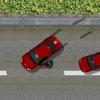ATI and GL_TEXTURE_RECTANGLE_ARB
I have found a puzzling bit of behavior on my friend's ATI card.
When using GL_TEXTURE_RECTANGLE_ARB, the coordinates are grabbed for the first bound texture after calling glEnable() with GL_TEXTURE_RECTANGLE_ARB.
Thereafter, all textures use those coordinates rather than the proper coordinates for their size.
To use the proper coordinates you have to call glDisable() with GL_TEXTURE_RECTANGLE_ARB and call glEnable() again which probably makes for a performance hit. You have to do this between binding every new Texture that uses this extension.
Can I get other people with ATI cards to verify this behavior?
i thought thats normal behavour..
read this extension, which has reference to your "GL_TEXTURE_RECTANGLE_ARB":
http://www.opengl.org/registry/specs/ARB/texture_non_power_of_two.txt
quoting:
5. How is a conventional NPOT target different from the texture
rectangle target?
STATUS: RESOLVED
RESOLUTION:
The biggest practical difference is that coventional targets use
normalized texture coordinates (ie, [0..1]) while the texture
rectangle target uses unnormalized (ie, [0..w]x[0..h]) texture
coordinates.
basicaly, you don't enable GL_TEXTURE_RECTANGLE_ARB. you use texture_non_power_of_two to have support for NPOT textures. and still don't glenable anything, it is enabled if it is in extensions string. it won't improve performance to turn it off on normal POT textures.
GL_TEXTURE_RECTANGLE_ARB will use coordinates as unnormalized and that's what your problem is.
read this extension, which has reference to your "GL_TEXTURE_RECTANGLE_ARB":
http://www.opengl.org/registry/specs/ARB/texture_non_power_of_two.txt
quoting:
5. How is a conventional NPOT target different from the texture
rectangle target?
STATUS: RESOLVED
RESOLUTION:
The biggest practical difference is that coventional targets use
normalized texture coordinates (ie, [0..1]) while the texture
rectangle target uses unnormalized (ie, [0..w]x[0..h]) texture
coordinates.
basicaly, you don't enable GL_TEXTURE_RECTANGLE_ARB. you use texture_non_power_of_two to have support for NPOT textures. and still don't glenable anything, it is enabled if it is in extensions string. it won't improve performance to turn it off on normal POT textures.
GL_TEXTURE_RECTANGLE_ARB will use coordinates as unnormalized and that's what your problem is.
I made a program to test it. It has a 2x3 and a 3x4 texture and tries to draw both textures completely.
Please post to say whether the screen changes when you hold down the spacebar! Also say what your graphics card is.
Download: Texture Rectangle Test
Here is the relevant code
Please post to say whether the screen changes when you hold down the spacebar! Also say what your graphics card is.
Download: Texture Rectangle Test
Here is the relevant code
glDisable( GL_TEXTURE_RECTANGLE_ARB ); glEnable( GL_TEXTURE_RECTANGLE_ARB ); // draw 2x3 glBindTexture( GL_TEXTURE_RECTANGLE_ARB, tex23 ); glBegin(GL_QUADS); glTexCoord2f(0,3); glVertex2f(50,200); glTexCoord2f(2,3); glVertex2f(50,50); glTexCoord2f(2,0); glVertex2f(600,50); glTexCoord2f(0,0); glVertex2f(600,200); glEnd(); if( GLFW_PRESS == glfwGetKey( GLFW_KEY_SPACE ) ) { glDisable( GL_TEXTURE_RECTANGLE_ARB ); glEnable( GL_TEXTURE_RECTANGLE_ARB ); } // draw 3x4 glBindTexture( GL_TEXTURE_RECTANGLE_ARB, tex34 ); glBegin(GL_QUADS); glTexCoord2f(0,0); glVertex2f(50,450); glTexCoord2f(0,4); glVertex2f(50,250); glTexCoord2f(3,4); glVertex2f(600,250); glTexCoord2f(3,0); glVertex2f(600,450); glEnd();
It changes. Radeon 9700 Cat 6.9
"read this extension, which has reference to your "GL_TEXTURE_RECTANGLE_ARB": "
That's a feature of GL 2.0
All texture can have non power of 2 dimensions, can be mipmapped, etc.
Since he is using GL_ARB_texture_rectangle, it not related to NPOT.
"read this extension, which has reference to your "GL_TEXTURE_RECTANGLE_ARB": "
That's a feature of GL 2.0
All texture can have non power of 2 dimensions, can be mipmapped, etc.
Since he is using GL_ARB_texture_rectangle, it not related to NPOT.
I need the advice of the community to proceed from here.
In order of preference:
1) Switch back to 2x textures only, using padding
+ More compatible with all cards
- Wastes texture memory (worst case 3/4 of texture memory)
2) Stay with texture rectangle and enable/disable texture rectangle between every texture
3) Use NPOT textures
4) Use Pixel buffers with glDrawPixels()
In order of preference:
1) Switch back to 2x textures only, using padding
+ More compatible with all cards
- Wastes texture memory (worst case 3/4 of texture memory)
2) Stay with texture rectangle and enable/disable texture rectangle between every texture
3) Use NPOT textures
4) Use Pixel buffers with glDrawPixels()
This topic is closed to new replies.
Advertisement
Popular Topics
Advertisement




